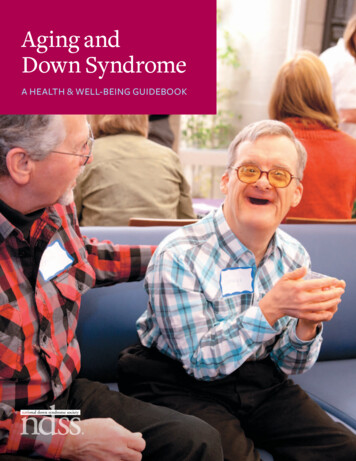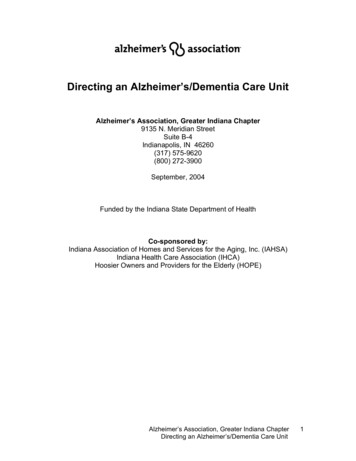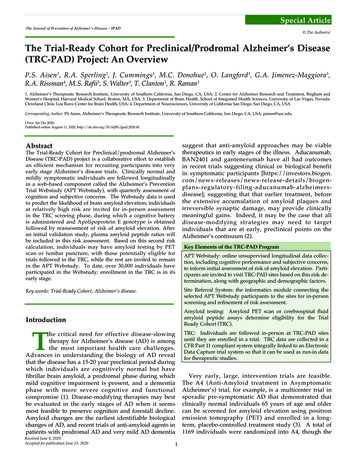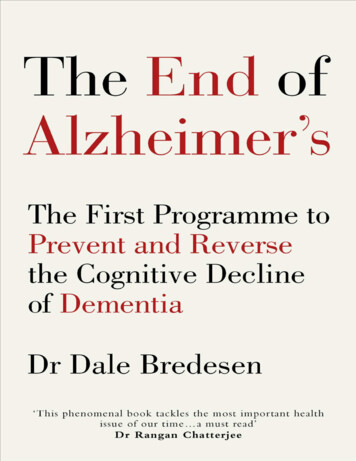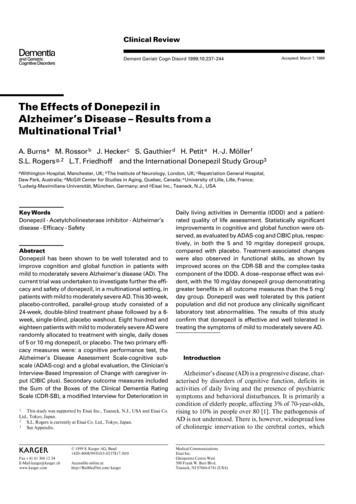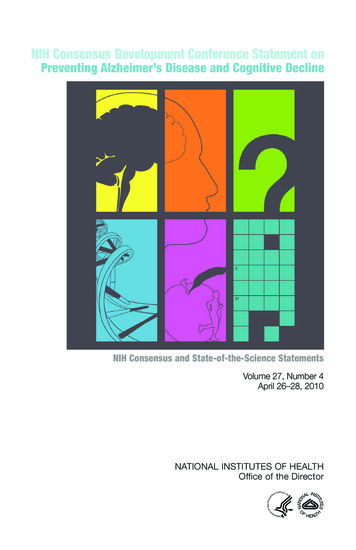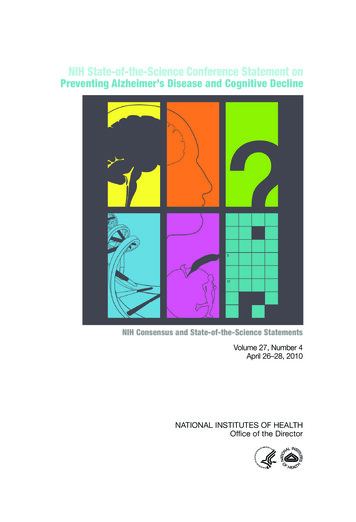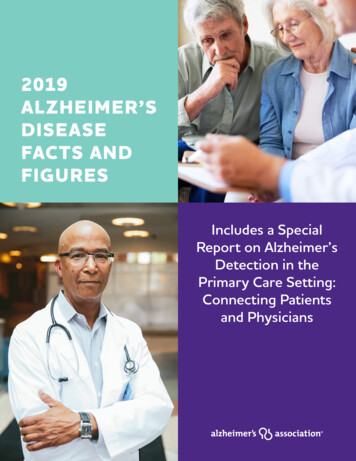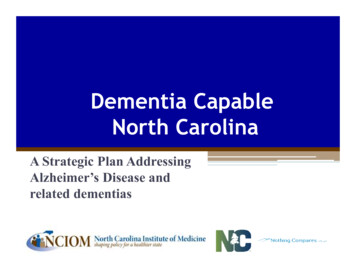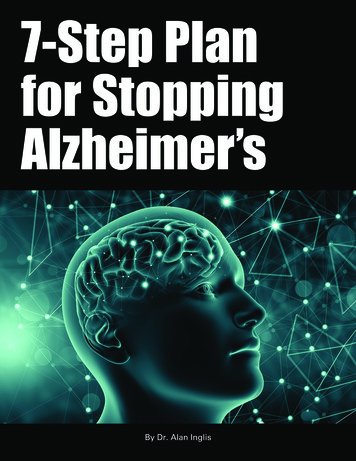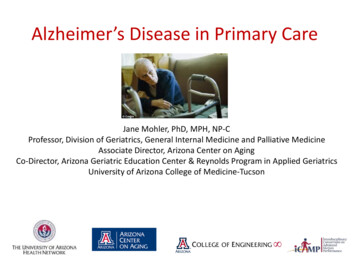
Transcription
Alzheimer’s Disease in Primary CareJane Mohler, PhD, MPH, NP-CProfessor, Division of Geriatrics, General Internal Medicine and Palliative MedicineAssociate Director, Arizona Center on AgingCo-Director, Arizona Geriatric Education Center & Reynolds Program in Applied GeriatricsUniversity of Arizona College of Medicine-Tucson
Objectives Briefly review epi of ADRD Discuss the context and ’s and –’s of screening and earlyintervention Discuss clinical recognition of symptoms Describe two AD primary care programs Education and training resources
Briefly Review- ADRD Epi 5.3 million diagnosed cases in US, increasing to 13.8 million in 2050Two-thirds of Americans with Alzheimer's are womenPrevalence of 8% in 65 & 43% in 85 AA and Hispanics higher rate than WhitesEvery 67 seconds someone in the US develops AD(Thies, 2012; Pimlot, 2009; Boustani, 2005; http://alz.org/facts/overview, 2015 Facts accessed3/2016 )
ADRD- To Screen or Not to Screen The debate The changes:1.2.3.4.5.6.Growing elder populationGrowing incidence of ADRD, & related Now 5 Rx’s for treatment, and other secondary prevention dataWelcome to MedicareAlzheimer's Disease Foundation Nov. 16 “National Alzheimer'sScreening Day,”Availability of caregiver training & support services
Why Not to Screen Diagnostic uncertaintyNo curative treatmentsFear of emotional distressPatient refusal for further workup if diagnosedMany clinical settings lack expertise in providing on-goingsupport services
AD Working Group Primary Care Survey2015 N 250 PCPs (mostly FP and IM in WA ) Importance of screening?– Very 78% / Somewhat 22% 46% did not know about cog. Screening in Welcome toMedicare 66% screened only when concerned re sx. Barriers to screeningAlzheimer’s Disease Working Group /developing-state-plan-address-alzheimers-disease
Dementia Case Finding Most patients with dementia receive medical care in primary care66% of them are not diagnosed in the early stagesClinicians and caregivers fail to recognize dementia symptomsLack of response is exacerbated by limited resources such as time andcost, Many clinicians have negative attitudes toward the value of detecting andmanaging dementia. Early case finding would reduce the time lag reported by many caregiversand families between the first notification of patient problems to cliniciansand activation of diagnosis, treatment, and support services
Why Recognize Early Sx? Respect for autonomy and decision-making–––––Gun, fire and driving safetyFinancial and legal issuesTreatment decisionsPlanning while having capacityResources and referrals Truth–telling is warranted ethicallyWilkinson H, et al. Sharing a diagnosis of dementia. Aging Ment. Health, 2003)
Two Early Recognition Programs Tucson Community FFHCCS and the Desert SouthwestAlzheimer’s Association in collaboration with AZ-CHOW andCHWs Banner University Internal Medicine ClinicBrayne C, Fox C, Boustani M. Dementia Screening in Primary Care: Is It Time?. JAMA. 2007;298(20):2409-2411.Solomon PR, Murphy CA. Should we screen for Alzheimer's disease? a review of the evidence for and against screeningAlzheimer's disease in primary care practice. Geriatrics. 2005;60(11):26-31
Community AZ-CHOW training in cognitive screening (AD-8) and how tocommunicate with concerned families Fax referral to PCP with AD8 Fax referral to DSAA for resources and follow-up Resources left in the home
AD8 Dementia Screening Interview1.2.3.4.5.6.7.8.Problems with judgment (e.g., problems making decisions, badfinancial decisions, problems with thinking)Less interest in hobbies/activitiesRepeats the same things over and over (questions, stories, orstatements)Trouble learning how to use a tool, appliance, or gadget (e.g., VCR,computer, microwave, remote control)Forgets correct month or yearTrouble handling complicated financial affairs (e.g., balancingcheckbook, income taxes, paying bills)Trouble remembering appointmentsDaily problems with thinking and/or memoryTOTAL AD8 SCORE2 or more yeses: Cognitive impairment is likely to be presentGalvin JE et al, The AD8, a brief informant interview to detect dementia, Neurology 2005:65:559-564Copyright 2005.
Banner University Internal Medicine Clinic MA screening with “are you concerned about your thinking ormemory? If so, AD-8 review with PCP If referral to DSAA, as desired F/u with diagnostics as is appropriate
Training Materials Alzheimer’s Association essentiALZ professional certificationand practical implementation tools via AZ-GWEP Certification 32 hrs of 1 hr modules
Dementia Warning SignsAn alternative to screening in primarycare settingsColin Thomas, MD, MPHInterim Chief, Division of Geriatric MedicineUCSD School of MedicineSection Chief, Hospital MedicineVA San Diego HealthcareCo-Chair – VHA Dementia Warning Signs Workgroup 2010-2012
Objectives Understand the concept of Dementia Warning Signs Identify Dementia Warning Signs Describe a process for initiating a dementia evaluation inprimary care, prompted by the presence of DementiaWarning Signs
Recommendations from VHADementia Steering Committee Use warning signs to trigger cognitive assessment Standardize diagnostic evaluation Conduct diagnostic evaluation in primary care settingexcept for complex cases Specialty referral for complex cases– Atypical or rapidly progressive– Early onset– Behavior problems or movement disorder
Charter Develop practice methods to implement Dementia WarningSigns in primary care Pilot test the methods for feasibility NOT a research study NOT designed as a large scale data collection throughout VAhealthcare systems
Why not just screen everyone over acertain age? USPSTF Insufficient Information to recommend either for oragainst routine screening– Limitations of existing screening tools– Limited data on outcomes from early detection and treatment inasymptomatic patients– Concerns about potential harms– Risk of diverting primary care time and resources from activitieswith strong evidence of benefit
Dementia Detection Challenges Up to 60% of cases are not diagnosed until later in thedisease Challenges occur at multiple levels:– Disease– Provider– rts1.asp
Possible Consequences ofUnder-Detection Poor chronic disease control and premature decline infunctional status Strained family relationships Delayed access to treatments Safety issues
A Warning Signs Approach Opportunistic case finding Observing and responding to behavior and/or concernsexpressed by caregivers Performing a focused history, physical examination, andbrief cognitive assessment Not an application of a standardized instrument orclinical reminder to all older veterans
Background Dementia Warning Signs Workgroup– Convened from 2009-2011 to develop written guidance forkey recommendation from VHA Dementia SteeringCommittee Multi professional team– Nursing, Psychology, Social Work, Pharmacy– Geriatrics, Psychiatry, Neurology, Primary Care Workgroup report and selected tools available assupplemental materials
Tools include Staff education slides Waiting room posters Warning Signs tear sheets FAQs26
Dementia Warning Signs Asking the same questions over and over againBecoming lost in places previously well knownInability to follow directionsConfusion over time, people, and placesLack of self care – nutrition, bathing, unsafe behaviors- NIH Alzheimer’s Disease Education and Referral (ADEAR) Center
Step #1Identify the Dementia Warning Signs
Watch, Ask, Be Aware If you see a Patient displaying a warning sign, askhim/her or a family member about warning sign behaviors Use resources to educate clinic staff and post reminders inthe clinic
Dementia Warning Sign Tools Training materials for front-linestaff Posters and tear sheetsthat list warning signs Electronic note templates FAQs
Dementia Warning SignsPosters and Tear Sheets
Step #2Conduct and Document Warning SignTriage Assessment
Triage Assessment Which warning signs are present?What is the time course?Are they affecting daily activities?Are there safety issues?Help provider prioritize actions– No further action– Defer to problem focused evaluation– Urgent assessment33
Step #3Conduct and Document DiagnosticAssessment (if necessary)
Outline of Recommended Evaluation- History Onset and time course of cognitive symptomsImpact on activities and social interactionsBehavioral problemsPast medical history including vascular risk, delirium,head trauma, vision & hearing, psychiatric disorders Medication review
Outline of Recommended Evaluation- History Family history of dementia or cognitive impairment Social History including support, education level, drugand alcohol use, driving and firearms Functional status assessment examples:– Katz– Lawton
Outline of Recommended Evaluation –Physical Exam Mental Status including mood, behavior and objectiveevaluation of cognitive function Neurological Cardiovascular Functional capabilities– Vision, hearing
Outline of Recommended Evaluation Laboratory CBCThyroid & Liver functionMetabolic PanelVitamin B12Urine AnalysisHIV* (with verbal consent documented)*The CDC now recommends HIV testing for all adults
Special Diagnostic Testing When indicated by history and exam findings––––––SyphilisHeavy metals or toxin exposuresMethylmalonic AcidEndocrine disordersTargeted rheumatologic tests for vasculitisLumbar puncture and CSF analysis
Outline of Recommended Evaluation Imaging Imaging is indicated when cognitive decline developssuddenly or is associated with focal neurological deficitsthat cannot be explained by known, preexisting pathology Highly recommended: When investigating or establishing thesuspected diagnosis of dementia for at-risk patients: VA providersshould obtain a CT or MRI if one has not been obtained within the pasttwo years
Outline of Recommended EvaluationBrief Cognitive Instruments BOMC – Blessed Orientation, Memory and ConcentrationGPCOG – General Practitioner Assessment of CognitionMini-CogMMSE – Folstein Mini Mental State ExamMoCA – Montreal Cognitive AssessmentSLUMS – St. Louis University Mental StatusSTMS – Short Test of Mental Status
DSM-5 criteria forneuro-cognitive disorder Evidence of significant decline in one or more cognitivedomains, preferably documented by a standardizedinstrument The cognitive deficits interfere with independence ineveryday activities The cognitive deficits do not occur exclusively in the contextof a delirium The cognitive deficits are not better explained by anothermental disorder
Feedback on Pilot Tests of DWS inPrimary Care Clinics Earlier detection without intrusive testing Earlier engagement dementia care management Clinicians more likely to note warning signs than Veteransor family caregivers CPRS template helpful in structuring evaluation No reports unnecessary evaluations
DWS in Primary Care Clinics: LessonsLearned Volume was not overwhelming– 0-2 cases per week Majority identified by clinic staff rather than Veteran orfamily caregiver report
DWS in Primary Care Clinics: LessonsLearned Impact on workflow is small––––Time to learn template, to address new problemEngaging non-provider staff leads to smoother workflowSmall number required specialty referralNo complaints of unnecessary evaluations
Summary Warning signs prompt further assessment– Warning signs are NOT diagnostic of dementia– Brief Cognitive Instruments NOT diagnostic– History, physical exam and labs Team-based care for optimal outcomes––––Patient and family educationCare coordination over time, settings, providersSupport for Veteran and caregiverMedications in accordance with guidelines
Alzheimer's Disease in Primary Care Jane Mohler, PhD, MPH, NP-C Professor, Division of Geriatrics, General Internal Medicine and Palliative Medicine Associate Director, Arizona Center on Aging Co-Director, Arizona Geriatric Education Center & Reynolds Program in Applied Geriatrics University of Arizona College of Medicine-Tucson

